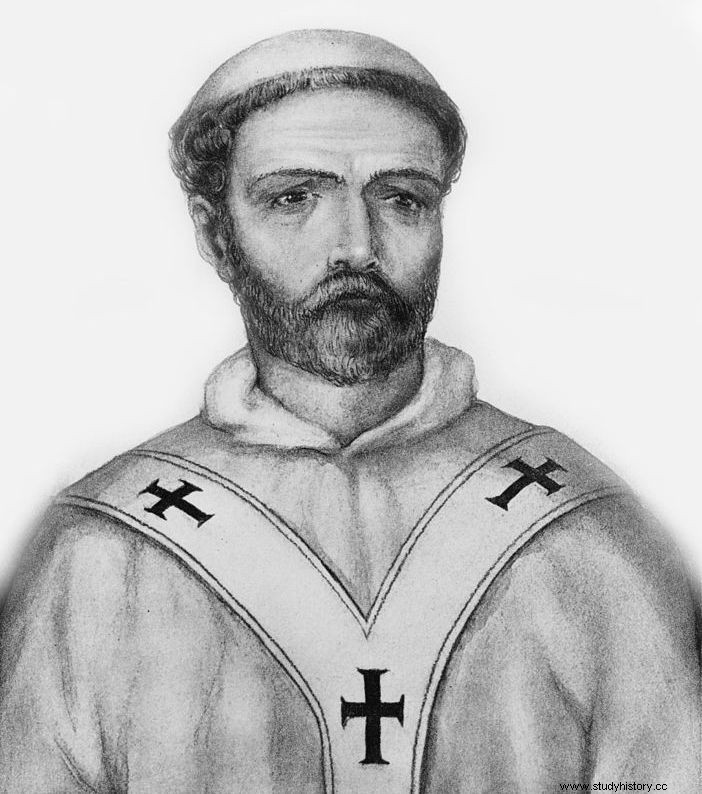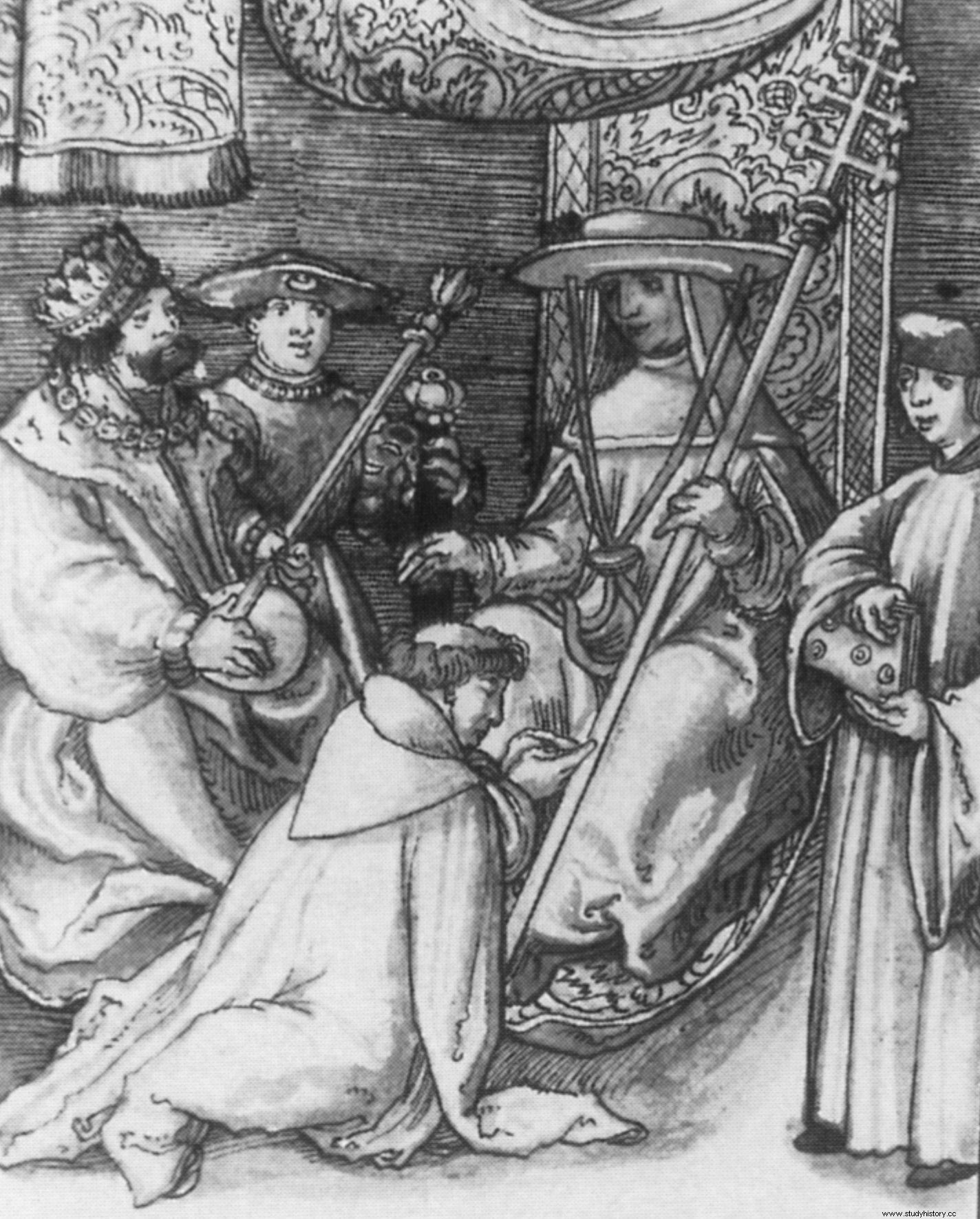John VIII was first nailed down by the court and then beaten to death. Alexander VI accidentally ingested poison intended for one of his guests. Jan X was strangled with a pillow. What about the rest of Saint Peter's successors?
John XII was associated with everything that the Pope should not be associated with. He was elected to the Chair of Peter in 955, not for merits and spiritual qualities, but for his connections. Anyway, what achievements could he have had at the age of eighteen ?! Worse, his thoughts were not divine, but mundane, and sometimes even diabolical.
The papal palace turned into a brothel. He was involved in bloody intrigues. Cutting bones, he called upon the pagan gods. Maybe he even worshiped them, because he usually avoided the sign of the cross. He died in the bedroom of his married mistress.
It is uncertain under what circumstances. One version says that the jurny 27-year-old had a stroke during intercourse. Another that he died at the hands of his lover's husband. Either way, the question is, was the death of the worst pope in history an accident? Or is it the result of a conspiracy?

The real symbol of the fall of the papacy is Alexander VI Borgia, who had five children.
There are more such things and ambiguities in the history of the papacy. Even if a death is considered mysterious, it is uncertain whether a third person was behind it. Also, if it is assumed that death was in someone's hand, it is difficult to find evidence of an attack. And sometimes it is not even known whether there was an attack or a… mistake!
Between poison and malaria
This was the case of the infamous Alexander VI Borgia (who died in 1503), who could boldly compete with John XII for the palm of priority among the least pious Holy Fathers. It is believed that the cause of his death was malaria, but it is possible that he accidentally took a poison prepared for one of the cardinals visiting him for lunch!
It is known that Urban VI could also fall victim to the poison (he died in 1389). This aggressive paranoid, who did not hesitate to imprison and torture reluctant cardinals, had so many enemies that it was quite likely.
The same is the case with Clement II (who died in 1047). In 1942, his tomb was opened and examined, and analyzes showed poisoning with lead compounds. It is possible, however, that the pope took the harmful preparations as an alleged medicine, or drank a lot of wine sweetened with lead acetate. In the case of the sudden death of Damasius II (a year after Clement), poison was also mentioned, although malaria was eventually identified as the more likely cause of death.
The orders of the pornographic age
Poison was not always enough. In 882 AD, the courtiers first nailed down and then bludgeoned to death. This was the beginning of the true black series. Three years later, Pope Adrian III died under unclear circumstances. After another two years, in the case of Stefan VI, there was no longer any ambiguity.
This pope "became famous" by having his former enemy, Pope Formosus, exhumed, then dressed in pontifical garments and judged. Condemned punishment:dismemberment of the deceased and thrown into the waves of the Tiber. It was too much for the people of Rome. They rebelled, imprisoned Stefan VI, and then someone strangled him in a cell.

Stephen VI organized the most macabre spectacle in the history of the papacy - the judgment of the corpse of his predecessor, Formosus.
And all this is just an introduction to the 10th century and the times of the so-called "pornocracy", when the Chair of Peter became the stake in the intrigues of papal courtesans and court coteries, and the corpse was thick. Pope Leo V was overthrown and imprisoned, and murdered in 904 so that he would no longer cause trouble. A similar fate happened to John X:in 928 he was removed from power, and in 929 he was strangled with a pillow so that he would not try to regain the throne.
It is possible that Marosia was behind his murder - the black mamba of the epoch who slept with one pope, killed another, and made another pope:her own son, who took the name of John XI. It happened after the suspicious death of Pope Stefan VII, a former protégé of Marosia. Eventually the mother viper and her subordinate son were also overthrown and left this world in AD 936. It is very possible that someone "helped" them.
Benedict VI (who died in 974) also ended tragically in the times of pornocracy. Removed from power, at the behest of his successor he was strangled. And one of the last popes of the bloody days of pornocracy was John XII, mentioned in the introduction. Another strange death that is.

After the death of Stephen VII, Marosia placed her son, who took the name of John XI, on the papal throne under suspicious circumstances.
The end of pornocracy (which coincided with the rule of John XIII, during whose pontificate the baptism of Poland took place in 966) did not mean that assassinations as a method of getting rid of current and former popes were discontinued. As early as 984, the death of John XIV aroused controversy:the deposed person was sent to prison, where he died either from exhaustion or as a result of - how else? - poisoning.
The Seventh Pope
If you add up all this and consider the doubts, it would turn out that at least six popes were most likely the victims of the attack:Clement II, John VIII, Stephen VI, Leo V, John X and Benedict VI. The methods were proven:mainly poison, choking, sporadic beating.
The death of Lucius II in 1145 was very different. If he fell victim to an assassin, he must have had an extremely accurate eye and a skilled hand. The Pope was killed by a stone when he led his supporters to attack the rebellious Romans defending themselves in the Capitol. However, it just looks like death in a riot fight. Likewise, it is difficult to consider the deaths of many Church leaders in the first centuries of Christianity as martyrdom.
In the case of Lucius II, however, there is a new thing:sudden, violent death in a crowd. This is something very rare with popes. And such a fate could also befall the Polish Pope - John Paul II.

Lucius II was hit by a stone during the Battle of the Capitol. He died of wounds after a few days of torment. In this 16th century German miniature, we see Archbishop Magdeburg Norbert von Xanten at the foot of this Pope.
After all, the attack took place during the general audience in Saint Peter's Square on May 13, 1981. This matter was recently discussed in the book Zamach. John Paul II - May 13, 1981. Conspiracy. Investigation. Confession ”by Jacek Tacik. You can learn about the circumstances of this dramatic event through the eyes of over twenty people interviewed by the author. Among them there are witnesses, doctors, investigators, agents, as well as the bomber himself - Ali Ağca.
It was not the last attempt on the Polish Pope. A year later, on May 12, 1982, during his pilgrimage to Fatima, priest Juan Maria Fernandez y Krohn, active in the conservative Priestly Society of Saint Pius X, attacked him. With the cry "away with the Pope!", He attacked John Paul II with a bayonet. For he considered him… a Soviet agent. However, even from these oppressions, John Paul II managed to survive. Otherwise, he would have become the next, at least the seventh, pope to die at the hands of an assassin.
